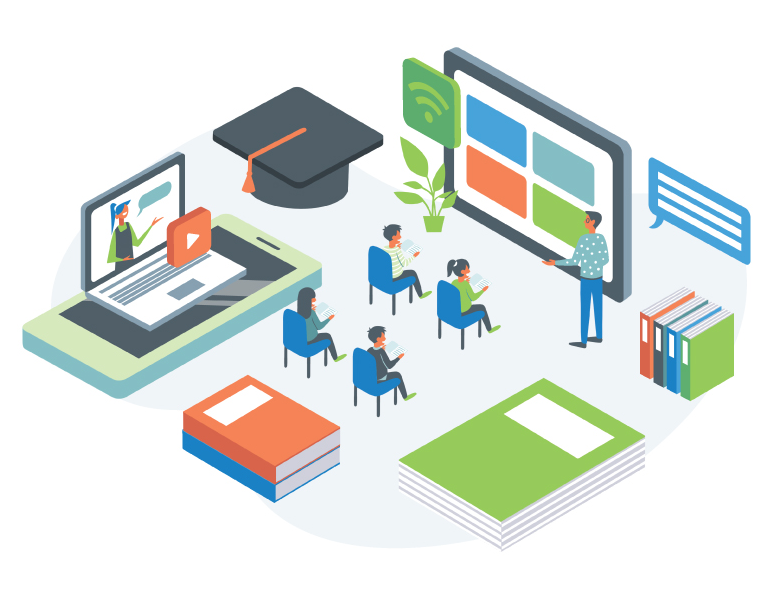How Technology Is Transforming the Classroom, where traditional learning meets innovative solutions, is reshaping the educational landscape. Digital tools are now integral to enhancing learning experiences, making education more engaging and accessible than ever before. From interactive applications to online learning platforms, technology empowers both students and educators, breaking down barriers and fostering collaboration like never before.
As we dive deeper into the impact of gamification, augmented reality, and data-driven decision-making, it’s clear that the integration of these technologies is not just a trend but a necessity. Schools are adopting these advancements to create immersive learning environments, personalized education experiences, and collaborative spaces that prepare students for a rapidly evolving world.
The Role of Digital Tools in Education
The integration of digital tools in education has revolutionized the way teachers deliver lessons and students acquire knowledge. These tools foster engagement, enhance collaboration, and provide personalized learning opportunities that cater to diverse learning styles. As classrooms become increasingly digital, the role of these technologies becomes pivotal in shaping the educational landscape.Digital tools enhance learning experiences by facilitating interactive and engaging methods of instruction.
For instance, technology allows for real-time feedback during lessons, promoting immediate understanding and application of concepts. With access to a wealth of online resources, students can supplement their learning beyond traditional textbooks, exploring multimedia content that enhances comprehension and retention. This variety of resources encourages students to take ownership of their learning, developing critical thinking and problem-solving skills.
Types of Digital Tools in Education
Various types of digital tools are currently being utilized in educational settings to enhance the learning experience. These include:
- Learning Management Systems (LMS): Platforms like Google Classroom and Moodle allow teachers to organize courses, distribute assignments, and track student progress efficiently.
- Interactive Whiteboards: Tools such as SMART Boards enable teachers to present lessons in dynamic ways, incorporating multimedia elements that captivate student attention.
- Educational Apps: Applications like Kahoot! and Quizlet facilitate interactive learning through gamification, making subjects more enjoyable and engaging for students.
- Virtual Reality (VR): VR tools, such as Oculus Rift, immerse students in virtual environments, providing experiential learning opportunities that are difficult to replicate in traditional classrooms.
- Collaboration Tools: Tools like Microsoft Teams and Slack promote teamwork among students, allowing them to work together on projects and communicate effectively from anywhere.
Successful implementations of digital resources in schools have shown promising results. For example, in the 2020-2021 school year, a study conducted by the Bill & Melinda Gates Foundation highlighted how the use of LMS increased student engagement and improved academic performance at several schools across the U.S. Similarly, a high school in California that adopted VR technology for its biology curriculum reported a 30% increase in student understanding of complex scientific concepts, demonstrating the potential of immersive learning experiences.Digital tools not only enhance individual learning but also promote a collaborative classroom environment where students can share ideas and learn from each other.
As technology continues to evolve, its role in education will undoubtedly expand, providing even more innovative ways to engage and educate the next generation of learners.
Impact of Online Learning Platforms
The rise of online learning platforms has significantly shifted the educational landscape, offering both students and teachers an array of opportunities and challenges. As traditional classrooms blend with digital environments, understanding the implications of these platforms becomes essential for maximizing their potential in education.Online learning platforms have transformed how education is delivered, providing flexibility, accessibility, and a wealth of resources.
They enable learners to access materials anytime, anywhere, catering to diverse learning styles. However, challenges such as digital divide issues, student engagement, and the need for self-discipline present hurdles that need addressing.
Benefits and Challenges for Students and Teachers, How Technology Is Transforming the Classroom
The advantages and obstacles of online learning platforms are multifaceted, impacting both students and educators.
- Benefits:
- Accessibility: Students can access a wide range of resources and courses from anywhere with an internet connection, breaking geographical barriers.
- Flexibility: Learners can study at their own pace, allowing for a personalized learning experience that accommodates individual schedules.
- Diverse Resources: Online platforms often provide multimedia content, interactivity, and gamification, which can enhance the learning experience.
- Challenges:
- Digital Divide: Not all students have equal access to technology and the internet, leading to disparities in learning opportunities.
- Engagement: Maintaining student motivation and participation can be challenging in a virtual environment.
- Self-Discipline: Students must develop strong self-regulation skills to manage their time and workload effectively.
Facilitation of Collaborative Learning
Online learning platforms create unique opportunities for collaborative learning, allowing students to engage with peers and instructors beyond traditional classroom boundaries. Collaborative tools such as discussion forums, group projects, and virtual classrooms foster interaction and teamwork. For example, platforms like Google Classroom and Microsoft Teams enable students to work together on assignments in real-time, share resources, and provide feedback to one another.
This method not only enhances comprehension but also builds essential communication and interpersonal skills.
Comparison of Popular Online Learning Platforms
Understanding the various online learning platforms available can help educators and students choose the best fit for their needs. Below is a comparison of some popular platforms and their distinctive features:
| Platform | Key Features | Target Audience |
|---|---|---|
| Coursera | University-level courses, certificates, and degrees from top institutions; high flexibility with course offerings. | College students and lifelong learners. |
| edX | Access to high-quality courses from universities; offers MicroMasters programs. | Higher education students and professionals seeking advancement. |
| Khan Academy | Free courses with a focus on K-12 education; personalized learning dashboard. | Students and teachers in primary and secondary education. |
| Udemy | Wide range of courses available at various price points; flexible course creation. | General audience, including professionals and hobbyists. |
Online learning platforms have made significant strides in enhancing educational experiences, yet the journey comes with its share of challenges. As technology continues to evolve, so too will the landscape of learning, encouraging both students and educators to adapt and thrive in this digital age.
Gamification in the Classroom
Gamification has emerged as a transformative approach in educational settings, utilizing game-like elements to enhance the learning experience. By integrating gamification strategies, educators can create a more engaging and interactive environment that motivates students to participate actively in their studies. This method leverages students’ intrinsic motivation and taps into their natural inclination toward play and competition.Gamification in education revolves around the application of game design principles such as scoring systems, badges, levels, and competition into lesson plans and curricula.
This strategy is not merely about playing games; instead, it’s about incorporating these engaging elements into learning activities to achieve specific educational outcomes. It fosters a sense of achievement, encourages collaboration, and nurtures problem-solving skills among students, making learning a more enjoyable venture.
Examples of Gamified Learning Activities
To illustrate the versatility of gamification in the classroom, here are some effective gamified learning activities designed to engage students and enhance their learning experiences:
- Classroom Quests: Students embark on quests that involve completing tasks and challenges, earning points as they progress through different levels of the adventure.
- Digital Badges: Award digital badges for achievements in various subjects, motivating students to strive for recognition in their learning journey.
- Trivia Games: Conduct trivia competitions where students answer questions related to the curriculum, fostering a competitive spirit and fun learning atmosphere.
- Role-Playing Exercises: Allow students to assume specific roles in historical or literary contexts, deepening their understanding through immersive experiences.
- Leaderboards: Create a leaderboard to track student progress and achievements, sparking healthy competition and encouraging continuous improvement.
- Escape Room Challenges: Design escape room activities where students solve puzzles and riddles to “escape,” promoting teamwork and critical thinking skills.
Incorporating game elements into lessons yields significant psychological benefits. By leveraging the principles of gamification, students experience a sense of autonomy and competence, which can lead to increased engagement and retention of information.
“Gamification promotes a sense of achievement and motivates students by providing tangible rewards for their efforts.”
Moreover, the use of gamified elements can reduce anxiety associated with traditional assessments, allowing students to focus on learning rather than solely on grades. The collaborative nature of many gamified activities encourages peer interaction and builds a classroom community, fostering social connections that enhance the overall educational experience. By tapping into these psychological aspects, educators can create learning environments that are not only more effective but also more enjoyable for students, ultimately leading to better educational outcomes.
The Use of Augmented and Virtual Reality

The integration of Augmented Reality (AR) and Virtual Reality (VR) into educational environments is revolutionizing the way students engage with learning materials. These technologies provide immersive experiences that enhance understanding and retention of complex subjects. As educators explore the potentials of AR and VR, their applications in the classroom demonstrate significant impacts on student engagement and learning outcomes.AR and VR technologies are being utilized in classrooms to create interactive learning environments that transcend traditional educational methods.
For instance, AR applications can overlay digital information onto physical objects, allowing students to visualize concepts in real-time. A notable example is the use of AR in anatomy classes, where students can use an app to view 3D representations of human body systems overlaid on their classmates or anatomical models. VR, on the other hand, offers fully immersive experiences. Programs like Google Expeditions allow students to take virtual field trips to historical sites or explore the depths of the ocean without leaving the classroom.
Educational Advantages of Immersive Learning Experiences
The benefits of AR and VR in education are numerous and significant. Immersive learning experiences foster higher levels of engagement among students, as they can visualize and interact with content in unprecedented ways. Key advantages include:
- Enhanced Retention of Information: Immersive experiences help students remember information better by allowing them to experience it firsthand rather than just reading about it. Research suggests that students retain 70% of what they learn through experiential activities.
- Increased Motivation and Engagement: The novelty and interactivity of AR and VR capture students’ attention, making learning more enjoyable. This increased engagement can lead to improved participation and enthusiasm in the classroom.
- Real-World Application of Skills: AR and VR allow students to practice skills in realistic scenarios. For example, medical students can use VR simulations to practice surgeries, providing a safe environment to learn from mistakes without real-world consequences.
- Diverse Learning Styles: These technologies cater to various learning styles, from visual and kinesthetic learners to those who benefit from interactive experiences. This inclusivity helps reach students who may struggle with traditional teaching methods.
Future Developments of AR and VR in Education
The future of AR and VR in education is promising, with ongoing advancements and applications poised to further enhance learning experiences. As technology evolves, here are some anticipated developments:AR and VR are likely to become more accessible and affordable for schools, enabling wider adoption across educational institutions. Enhanced hardware and software capabilities will allow for more sophisticated simulations and interactive experiences.
For instance, advancements in haptic feedback technology could enable users to feel the textures or shapes of virtual objects, further enriching the immersive experience.Institutions are expected to develop tailored AR and VR content that aligns with curricula, providing customized learning experiences that meet diverse educational needs. As collaboration tools become more integrated into AR and VR platforms, students could work together in virtual environments, fostering teamwork and communication skills.In summary, the use of Augmented and Virtual Reality in classrooms is reshaping education, making learning more engaging, effective, and adaptable for the future.
Data-Driven Decision Making in Education
In today’s educational landscape, data-driven decision making has emerged as a vital component in enhancing teaching strategies and improving student learning outcomes. By leveraging data analytics, educators can gain valuable insights into student performance, engagement, and overall effectiveness of their instructional methods. This shift towards data-informed practices allows teachers to tailor their approaches to better meet the diverse needs of their students, ultimately fostering a more effective learning environment.Data analytics serves as a powerful tool in education, enabling educators to identify trends and patterns in student behavior and academic performance.
This information can be used to refine teaching strategies, adjust curriculum pacing, and provide targeted interventions for students who may be struggling. The importance of tracking student performance and engagement metrics cannot be overstated; it offers a clear picture of how well students are absorbing material and helps educators discern which methods are yielding positive results.
Importance of Tracking Student Performance and Engagement Metrics
Tracking student performance and engagement is crucial for understanding the dynamics of learning in the classroom. By monitoring these metrics, educators can make informed decisions that enhance instructional effectiveness. The following points highlight the significance of these practices:
-
Data provides insights into student understanding, allowing teachers to adjust lessons in real-time.
- Engagement metrics indicate the level of student interaction with the material, which is vital for retention and comprehension.
- Performance tracking helps identify students at risk of falling behind, enabling timely interventions that can alter their educational trajectory.
- Regular analysis of data can reveal trends over time, such as improvements or declines in specific subject areas, guiding curriculum development.
Methods for Teachers to Effectively Utilize Data in the Classroom
To harness the power of data in the classroom, educators can implement a variety of methods that enhance instructional practices. These methods facilitate the effective use of data analytics to improve student outcomes:
- Utilizing learning management systems (LMS) to gather and analyze student data efficiently.
- Employing formative assessments to generate immediate feedback, which can inform teaching adjustments on-the-fly.
- Creating data dashboards that visualize student performance trends, making it easier to identify areas needing attention.
- Encouraging peer collaboration among teachers to share insights and strategies based on data findings, fostering a culture of continuous improvement.
The integration of data-driven decision making into education not only enhances teaching strategies but also significantly impacts student learning outcomes. By understanding and utilizing data effectively, educators can create a more responsive and dynamic learning environment that addresses the needs of every student.
Collaborative Learning through Technology
The landscape of education has evolved significantly with the advent of technology, particularly in how students collaborate with one another. Collaborative learning through technology transcends traditional classroom boundaries, empowering students to work together, share ideas, and solve problems in innovative ways. This approach not only enhances learning outcomes but also helps students develop essential skills for the modern workforce, such as communication, teamwork, and adaptability.Technological tools play a crucial role in fostering collaboration among students, allowing them to engage with peers in meaningful ways.
Here are some prominent tools that facilitate collaborative learning:
Technological Tools for Collaboration
Various platforms and applications can enhance collaborative learning experiences. These tools enable students to connect, communicate, and create together, regardless of their physical location. Some notable options include:
- Google Workspace for Education: This suite of tools, including Google Docs, Sheets, and Slides, allows multiple users to work on documents simultaneously, providing real-time feedback and fostering teamwork.
- Microsoft Teams: Combining chat, video conferencing, and file sharing, Teams provides a comprehensive platform for group projects and discussions, streamlining communication and collaboration.
- Padlet: A virtual bulletin board that enables students to post messages, images, and links, Padlet encourages collective brainstorming and idea sharing in a visually appealing format.
- Slack: Popular in professional settings, Slack can also be used in educational environments to facilitate communication among students, helping to maintain focus on group tasks.
- Trello: This project management tool allows students to organize tasks and track progress collaboratively, ensuring clarity on responsibilities and deadlines.
Effective collaboration goes beyond just using the right tools; it also requires intentional strategies to foster teamwork and communication in digital spaces. Implementing best practices can significantly enhance collaborative experiences for students.
Best Practices for Fostering Teamwork and Communication
Creating an environment conducive to collaboration involves implementing best practices that promote teamwork. Here are some effective strategies to consider:
- Establish Clear Goals: Clearly defined objectives guide students in their collaborative efforts, ensuring everyone understands the purpose of their teamwork.
- Encourage Active Participation: Use techniques that encourage all group members to contribute, such as assigning specific roles or rotating responsibilities within the team.
- Provide Structured Guidelines: Clear guidelines for communication, deadlines, and expectations help maintain focus and accountability among group members.
- Utilize Collaborative Tools Effectively: Ensure students are trained in how to use the chosen tools, maximizing their potential for effective collaboration.
- Foster a Supportive Culture: Encourage an inclusive atmosphere where students feel comfortable sharing ideas, asking questions, and providing feedback to one another.
Social media platforms also play a significant role in enhancing collaborative learning environments. These platforms facilitate communication and connection among students, allowing them to share resources and collaborate on projects easily.
The Role of Social Media in Collaborative Learning
Social media can significantly enrich collaborative learning experiences by fostering interaction and engagement among students. Here’s how social media enhances collaboration:
- Facilitated Communication: Platforms like Facebook groups or Twitter allow students to connect, share ideas, and discuss coursework outside of traditional class hours.
- Resource Sharing: Social media serves as a space for students to exchange links, articles, videos, and other resources, broadening their learning opportunities.
- Peer Support Networks: Students can form study groups or support networks through social media, encouraging collaboration and mutual assistance in their learning journeys.
- Real-Time Feedback: Social media enables students to receive immediate feedback from peers and instructors, enhancing the learning process through discussion and reflection.
- Global Connections: Students can connect with peers from around the world, gaining diverse perspectives and insights that enrich their collaborative projects.
The Role of Artificial Intelligence in Personalizing Education: How Technology Is Transforming The Classroom
Artificial Intelligence (AI) is rapidly changing the landscape of education by allowing for a more personalized learning experience tailored to individual student needs. By analyzing student data and performance, AI can adapt learning materials and methods, providing a customized educational journey that enhances engagement and productivity.AI applications in educational settings are diverse and impactful. For instance, platforms like DreamBox Learning utilize AI algorithms to monitor student progress and adapt math lessons in real time.
Similarly, Grammarly offers personalized writing feedback to students, helping them improve their language skills based on their specific weaknesses. These tools illustrate how AI can create a more tailored approach to learning that resonates with each student’s unique pace and style.
Examples of AI Applications in Education
The integration of AI in education has led to various innovative applications that demonstrate its potential for personalizing learning experiences. Each application serves to enhance student engagement, understanding, and overall academic performance. Here are some notable examples:
- Intelligent Tutoring Systems: Systems like Carnegie Learning use AI to provide one-on-one tutoring, adapting to student responses and pacing to offer immediate feedback and targeted practice.
- Adaptive Learning Platforms: Platforms such as Knewton adjust the content delivery based on real-time analytics of student performance, ensuring that learners are presented with materials suited to their current understanding.
- Chatbots for Support: Chatbots like the ones developed by IBM Watson assist students with inquiries, providing personalized responses that help alleviate common learning obstacles and frustrations.
- Automated Grading: Tools such as Gradescope utilize AI to speed up the grading process, providing teachers with more time to focus on personalized instruction and support.
The ethical considerations surrounding the use of AI in education are significant and warrant careful attention. Concerns arise regarding data privacy, as the collection of student information can lead to potential breaches of confidentiality. It’s essential that institutions implement robust data protection measures to safeguard sensitive information. Additionally, there is the risk of algorithmic bias, where AI systems may inadvertently reinforce existing inequalities if not carefully monitored and managed.
“The use of AI in education must be guided by ethical frameworks to ensure fairness and equity among all learners.”
Moreover, transparency in how AI systems make decisions is crucial. Educators and stakeholders should understand the algorithms used to personalize education to maintain trust in these technologies. Continuous dialogue among educators, technologists, and policymakers is vital to navigate these ethical waters while maximizing the benefits of AI in personalizing education.






